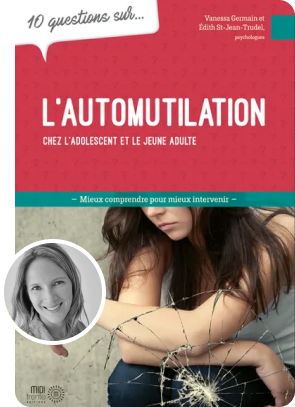Recognizing psychological distress
Understanding Self-Mutilation in Teens
Recognizing psychological distress
Understanding Self-Mutilation in Teens
Author:
Vanessa Germain PhD, psychologist
Self-mutilation or self-harm, the act of deliberately hurting oneself, is a particularly confusing and scary topic for parents of teens. While often seen as an extreme and marginal behaviour, self-harm is actually more common than most people would expect. Today, it is estimated that 15 to 20 percent of teenagers have engaged in some form of self-harm at least once between the ages of 11 and 15.
Who is at risk?
Teenagers who are most likely to engage in this type of behaviour are those who:
• find it difficult to manage their emotions;
• have suffered a relationship break-up or conflict, or;
• have experienced child abuse or childhood trauma.
Self-harm is also common among teens diagnosed with anxiety disorders, depression, eating disorders or borderline personality disorder.

Is self-harm a reckless act?
A teenager who turns to self-harm is in fact trying to expose their emotional suffering. Often incorrectly associated with suicidal thoughts, self-harm is first and foremost a way of dealing with and communicating emotions.
There are a number of reasons why some teens self-harm:
• To make their loved ones aware of their suffering and distract themselves from the painful negative emotions that they’re unable to communicate;
• To express or communicate an emotion, as though the extent of their emotional suffering prevented them from finding the words to express it in a healthier way;
• To punish themselves for what they see as failures in their lives;
• To feel something, anything, to escape from feeling numb or cut off from their emotions, or from reality.
Did you know?
Self-harm releases an endorphin that is shown to relieve pain and have a soothing effect. This helps explain why some people say they feel better after inflicting self-harm.
What are the signs to look for?
While it’s not always easy to know if a teenager is showing signs of self-harm, you should keep an eye out for the following behaviour:
What are the signs to look for?
While it’s not always easy to know if a teenager is showing signs of self-harm, you should keep an eye out for the following behaviour:

Teen self-harm: What to do? 🤔
As a parent, learning that your teenager is engaging in self-harming behaviour can come as a huge shock that can lead to feelings of anxiety, worry, sadness, guilt and helplessness. Some parents might even feel disheartened or angry. Know that all of these reactions are perfectly normal and valid.
Here’s some advice on how to best manage the situation:
• Try to remain as calm as possible and refrain from judging or laying blame; your teen needs to feel that you understand that they’re suffering;
• Communicate with them in a constructive, caring and calm manner so that they know they can trust you and come to you for help.
• Don’t try to hide dangerous objects; they’ll find others, or might even turn to more extreme measures.
• Encourage your teen to talk to a psychotherapist, as their behaviour could be a symptom of a more complex issue.

Let’s focus on prevention!
The best way to prevent teen self-harm is to:
- teach your teen to manage their emotions and anxiety at an early age;
- encourage your teen to talk about their concerns and challenges; and
- identify what triggers your teen so that you can help prevent it.
For more information, consult the sections of our website or contact a healthcare professional.
Teen meditation, mindfulness and mentalization: tools for every day →
Talking to teens: How to maintain a good relationship →
Resources for helping teens with depression or psychological distress →
Need to talk about what you are going through with your teenager?
Contact Ligne Parents for free 24/7 professional support

Learn about the contributor’s book
Finding out that someone you care about is deliberately hurting themselves can be very upsetting. Family members often experience a great deal of anxiety and helplessness and may be unsure how to react.
This book offers some insight into the act of self-harm by providing clear answers to 10 frequently asked questions and, above all, outlining proven strategies and courses of action to provide better support for teens and help them safely and effectively overcome their challenges.
This guide offers reassurance and answers for parents and caregivers concerned about teens and self-harm.
Buy the book ↗
Our partner
Les Éditions Midi trente offers practical books and helpful intervention tools aimed at helping people young and old overcome challenges and foster their potential.
